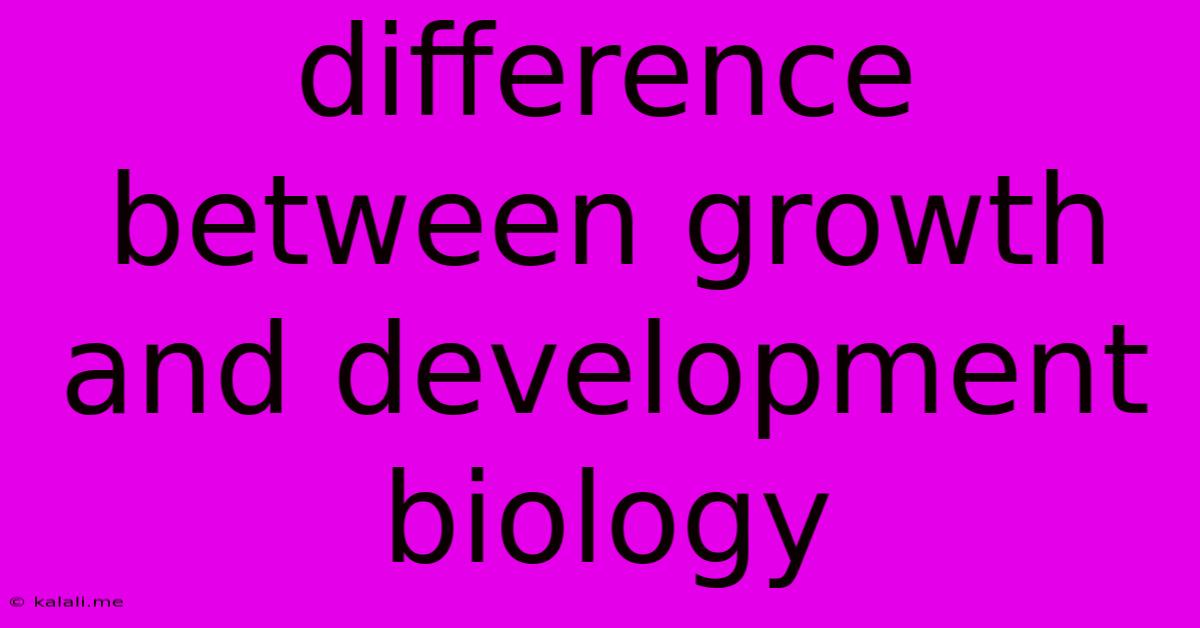Difference Between Growth And Development Biology
Kalali
Jun 13, 2025 · 3 min read

Table of Contents
Growth vs. Development in Biology: Understanding the Key Differences
Understanding the difference between growth and development in biology is crucial for comprehending the complexities of life. While both processes are integral to an organism's life cycle, they represent distinct aspects of its journey from a single cell to a mature entity. This article delves into the nuances of each process, highlighting their key differences and interrelationships.
Growth, in a biological context, primarily refers to an increase in size, mass, or number of cells. It's a quantitative change, measurable in terms of height, weight, volume, or cell count. Think of a plant seedling growing taller or a human child gaining weight. This increase can occur through cell division (increasing the number of cells) or cell enlargement (increasing the size of individual cells). Growth is often characterized by its relatively simple mechanisms and focus on quantitative expansion.
Development, on the other hand, encompasses a broader range of processes. It involves qualitative changes in an organism, transforming it from a simple structure into a more complex and organized entity. This transformation includes differentiation, morphogenesis, and maturation. Let's break these down:
Key Aspects of Biological Development:
-
Differentiation: This refers to the process by which cells become specialized, acquiring unique structures and functions. A single fertilized egg cell, through a series of intricate molecular signals and interactions, gives rise to diverse cell types, such as muscle cells, nerve cells, and skin cells, each with specialized roles within the organism. This cellular specialization is fundamental to the formation of tissues, organs, and organ systems.
-
Morphogenesis: This term describes the shaping and patterning of tissues and organs. It encompasses the coordinated movements and interactions of cells that lead to the formation of the body plan, the arrangement of tissues and organs in their correct spatial locations. Think of the intricate formation of the limbs, the development of the heart, or the organization of the nervous system.
-
Maturation: This refers to the process by which an organism achieves its full functional capacity. This involves the progressive refinement of structures and functions, leading to the organism's ability to reproduce and fully participate in its environment. Maturation often involves the attainment of reproductive competence.
Key Differences Summarized:
| Feature | Growth | Development |
|---|---|---|
| Nature of Change | Quantitative (increase in size/number) | Qualitative (increase in complexity) |
| Primary Process | Cell division, cell enlargement | Differentiation, morphogenesis, maturation |
| Measurement | Measurable (weight, height, cell count) | Difficult to quantify directly |
| Focus | Increase in size or number | Organization and specialization |
The Interplay Between Growth and Development:
It's crucial to understand that growth and development are not mutually exclusive processes; rather, they are intricately intertwined. Growth often provides the raw material for development, supplying the necessary cells for differentiation and morphogenesis. For instance, a plant needs to grow (increase in size) to have enough cells to differentiate into leaves, stems, and roots. Similarly, a human embryo needs to undergo significant growth to accommodate the developmental processes of organogenesis. While one can conceive of scenarios where growth occurs without significant developmental changes (e.g., simple cell division in bacteria), true development always necessitates some level of growth to build the necessary structures.
Conclusion:
In summary, while both growth and development are fundamental aspects of biological life, their distinctions lie in the nature of the changes they encompass. Growth focuses on quantitative increases, while development emphasizes qualitative transformations in complexity and organization. Understanding this distinction is pivotal to fully appreciating the intricacies of life and the remarkable processes that shape living organisms.
Latest Posts
Latest Posts
-
Energy Stored In The Bonds Between Atoms Is Called
Jun 14, 2025
-
Which Statement About Cells Is True
Jun 14, 2025
-
Greatest Common Factor Of 56 And 84
Jun 14, 2025
-
Clutch Pack Limited Slip Differential Diagram
Jun 14, 2025
-
Average Gpa At University Of Toronto
Jun 14, 2025
Related Post
Thank you for visiting our website which covers about Difference Between Growth And Development Biology . We hope the information provided has been useful to you. Feel free to contact us if you have any questions or need further assistance. See you next time and don't miss to bookmark.